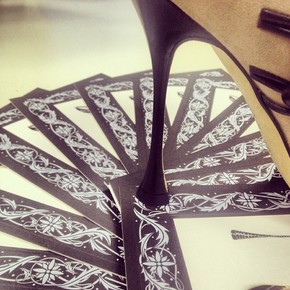Manolo Blahnik , the Spaniard behind the stiletto empire, does.
Colin McDowell from Fashion Business interviewed the maestro of soles, and it makes for a cool read. Ladies, enjoy!
Colin’s Column | Manolo Blahnik’s Marvellous Stories
BATH, United Kingdom — Manolo Blahnik, who in his variety and wit is surely the Mozart of shoemakers, leans forward confidentially and, almost in a whisper, says he is going to tell me something absolutely shocking. I also lean forward, anxious to miss none of it. He starts promisingly. “When I was in Chicago or somewhere like that talking to my customers,” he says, lowering his voice to a dramatic pitch suitable for the occasion, “I was appalled to find that when I mentioned Oscar Wilde’s play, Salome, in connection with one of my shoes, they had never even heard of Oscar Wilde!” He rears back, eyes rolling dramatically.
I understand where he is coming from and it is a great pity as everyone of Manolo’s couture shoes is ‘born’ in his head and has a history from the moment he picks up his Chinese brushes and begins to sketch. I know this because I have watched his hands flying like quicksilver across the sheet of paper as he tells the story of the woman whose life is summed up in the shoe. “She is from Dar es Salaam and she has left her husband who beats her, and is now on the way to the station where she will get onto the train that will bring her to her lover’s arms and freedom.” The next creation is a wedge heeled shoe and Manolo knows everything about it before he even starts to draw. “This is for a woman from Rio. So Carmen Miranda!” he says. “Very passionate, a little vulgar, but always laughing and ready for fun. She loves the raffia roses on the heels. They make her feel free to spend all of her husband’s money… This is borderline Liz Taylor on a bad day… This woman is a little prim — like Edinburgh… This sandal is for a beautiful Italian girl…” Every shoe has a story.
I have sat in Manolo’s study in his Georgian house in Bath entranced by the stream of marvellous stories ad characterisations that animate the shoes that he produces with such great energy and certainty. He knows within seconds of the first line on the paper whether or not the shoe will work as a stimulus to the brief biography that makes it real for him. And, if it doesn’t, he scrunches up the paper dramatically and hurls it to the floor, stillborn and instantly forgotten. It is a great performance to watch. But then, Manolo Blahnik is one of the world’s great entertainers. Urbane, elegant (always in Anderson and Shepherd bespoke suits, Charvet ties and shoes from his very small and exclusive menswear range) it is as impossible to imagine him in sweatshirt and jeans as it is to picture the Queen in a onesie.
But it is not his appearance alone that makes Manolo such a total original. It is his amazing mind. It is a true cabinet of curiosities, crammed with memories of the life and times of this man who darts in and out of the fashion world like a demented dragonfly or a character from Alice Through the Looking Glass – always with us but never entirely of us. Manolo’s world is a cultural cornucopia and, like his language, veers wildly across the spectrum from high camp to low Bronx with favourite expressions (“This is divine!” “Are you kidding?” and his generic term for all designers younger than his 71 years by around twenty: “the youngsters”). But Manolo Blahnik is no ivory-tower figure, tucked away from life. Even though his niece, Kristina, describing the joy of working with him, says , “I am constantly amazed at his vast, profound cultural literacy. His mind works at the speed of light and he moves from topic to topic so quickly that to get him to focus on one thing for a period of time without distraction can be a challenge.”
Because Manolo has a wide grasp and knowledge of history and cultures, he could be seen by many to be in a world of his own making, with constant returns to the pleasures of his younger days as a student in Geneva and London, but if so (and I would not agree with such an assessment), it is a world that is also finely attuned to everything that is contemporary, everything that is going on now. He is no dreamy dilettante in love with himself in a hermetically sealed bubble. He is entirely aware of the modern world and that includes the economics of running a business, which he has done successfully for years with his sister Evangelina. He spends weeks on end visiting his six factories in Italy and travelling on promotional tours – there are currently 11 free-standing shops and over 250 points of sale in 28 countries worldwide, which are in keeping with Kristina’s comment that the company is about “optimising growth, not maximising it.” And, although she occasionally travels with him, Manolo frequently spends many nights in hotels alone, where he voraciously devours television. As a result he is as switched on to what is going on in the world as anyone, even if he does tend to dismiss much of what he sees, as he also does my suggestion that his shoes are very expensive. “Not any more,” he counters. “I see shoes by some squalid designer or other and they cost £800 for something that I can sell for £600. As creator, I find this offensive to the customer and myself.”
His great hobby is movies and he talks with passion and excitement of the joys of Turner Classic Movies in hotels in the States. Manolo is a true movie buff, with an encyclopaedic knowledge of not only the great films of the past but also B movies from the Thirties and Forties, and of course the latest films of today. And when I say encyclopaedic, that is what I mean. He once told me that he watches his favourites so frequently that he knows the names of everybody technically involved, from the scriptwriters and composers – he can sing from memory a vast number of scores for background music – to the gaffer and best-boy grip. But it is the directors and stars that he knows even better. His favourite actress is Romy Schneider and his film favourite, although hard to choose from a very wide range, would almost certainly be Visconti’s masterwork, The Leopard, set in his favourite landscapes in Sicily during the nineteenth century, his favourite historic period. And he notices and remembers every nuance of a performance, no matter how minor. He has told me in the past that he knows and can copy every movement of the Tarlatan twins in Gone with the Wind – even though they are in fact very minor characters seen briefly.
Manolo Blahnik’s cultural roots were put down when he was a young boy in the Forties and Fifties enjoying a privileged upbringing in the Canary Islands, which was a very remote place indeed at that time. It made him thoughtful, even introspective, but also one of the great talkers of all time. His father was Czechoslovakian and his mother a native of Santa Cruz de la Palma, where Manolo and Evangelina were born and brought up. Although not a lonely upbringing, it was an enclosed one and that is probably how he became a voracious reader and film fan. Even today, he is always reading at least one novel and a couple of biographies simultaneously and normally in its original language. He is currently rediscovering Balzac in the original French. In fact, he is as multi-lingual as he is multi-cultural. As he says, “I am not so intellectual but I am very curious.” He might have added that he has a truly phenomenal memory that includes trivia and gossip as much as hard critical and historic fact. Unlike many fashion designers, he can tell his Biedermeier from his Bauhaus.
When he came to London, via a short period in Geneva, he had only a vague idea about a career but like many bachelors, he was very lucky in the women he met, including Paloma Picasso, Tina Chow, Anna Piaggi, Bianca Jagger and the then editor of British Vogue, Beatrice Miller. He remembers her with affection (she died a short time ago) and also one of her stylists, Grace Coddington, a long time friend with whom he once did a Vogue shoot staring opposite Angelica Huston. But the truly seminal woman in his life was the legendary Diana Vreeland, to whom he showed some of his drawings for stage designs and costumes. With the unswerving certainty that was the secret of much of her success, she told him to forget about the theatre and concentrate on designing shoes. He never looked back.
He had to learn from scratch – although there is a possibly apocryphal tale that, as a small boy, Manolo made shoes out of sweets wrappers for the small lizards he caught in his mother’s garden. And initially there were mistakes, including the high rubber heeled shoes he made for an Ossie Clark fashion show. The day was hot and as the girls walked down the runway the rubber began to melt, with predictable results. But Manolo learned his lesson and began to take his new trade seriously. A proof of how well he did so is the private museum of 20,000 pairs of shoes that he has made during his career. The are all stored in special cupboards and when the doors are thrown open – the cupboards stretch across the upper rooms of two houses – the effect is stunning. Although each shoe is totally a ‘Manolo’, the range and originality of his ideas and inspirations make it very clear why he is such a power in his field.
But it is not merely the beauty. Manolo Blahnik is a craftsman and he understands the geometry of a shoe – especially one with a high heel. As he says, “Even if the heel is only 12 centimetres high it has to feel secure, and that is why I go to the factories and carve each prototype heel personally on the machine and then by hand with a chisel, until it is exactly right and then can be produced by the craftsmen.” He once told me that his happiest moments were the ones he spent on this process in his factories, and I believe him. So it is no surprise to be told that two of his great influences are the British sculptors Henry Moore and Barbara Hepworth, who he says are a constant inspiration, adding, “It is all about shape.” But that is to forget his subtle and yet bold colour palette which, along with delicate embroidery, are the hallmark of a Manolo, as much as the delicate strength that you are aware of even when it is nestling in your palm.
There have been many new shoemakers in the last dozen years, some of whom Manolo rates, but his real praise is reserved for the masters of the past: Perugia, Ferragamo and, above all, Roger Vivier. He makes an interesting point: “I do not know what jealousy or envy are. I am entirely happy in my work. When the business took off in the Nineties, I knew that we were doing something popular but I didn’t think about being famous. It never occurred to me that something like that could happen.”
How wrong can you be?




No comments:
Post a Comment